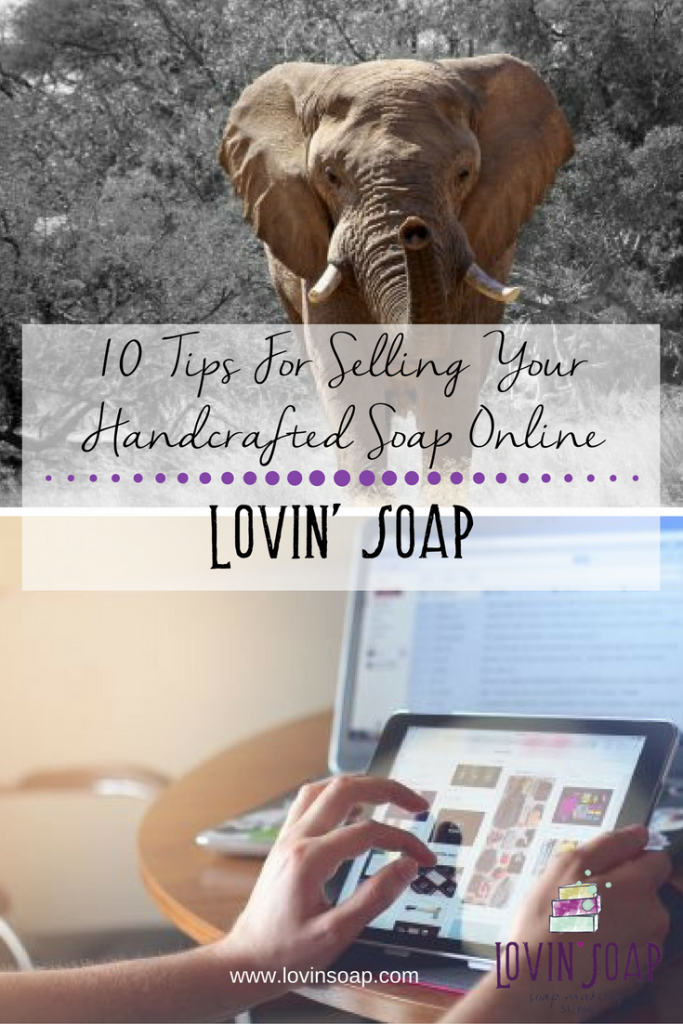There are far too many clichés out there stating that you will be successful as long as you are doing what you love.
Wrong.
You have to be smart about how you go about things, and you have to put in the work. Our industry is wide, vast and ever-burgeoning. I deeply believe that there is enough room for all soap and body care makers out there, but you really have to fine-tune your business in order to make waves in cyberspace. I would challenge all of you who have an online commercial site to see what you are currently doing, objectively look at your current rate of success, and then ask yourself, “Could I be doing better?”
If the answer to that is, “Yes, I could be doing better online,” then let’s take a look at a few things you can do quickly and easily to start selling your wares more consistently and with greater quantity.
-
Is what you are currently offering online good enough?
I know you love what you make. We all do. It matters on a level that can’t really be comprehended in words. But do your potential customers love it as much as you and your family do? Alas, when you make the transition from joy-creation to commerce-production, you really have to put your objective, super-business hat on.
Is there a legitimate market for your products, and if so, do your products stand out enough to compete with the ever-expanding competition that is currently online? Maybe you set out to make 100% vegan soap and that was your hard-lined rule as a business, but then every other customer you talk to keeps asking for goat milk soap. Maybe you offer one if you find it fitting for your company. Keep in mind you can’t please everyone, but at the very least, be willing to read the tea leaves if they keep popping up.
-
One bite at a time.
How do you eat an elephant? One bite at a time.
Through my coaching programs, I work with so many folks who come into my first phone session with a craft/hobby mindset. My goal with everyone is to instill a business mindset by the end of the program. So I will ask you, when it comes to your online business, do you have a craft/hobby mindset or a business mindset?
The best way I analogize a craft/hobby mindset is a sprint, where as a business mindset is a marathon. A craft/hobby person is out for the next show, clawing and scratching to get things prepared to sell their wares at the next event (which is perfectly fine). They sprint to the next event and almost collapse of exhaustion when it is over and the car is packed up. Sound familiar?
The business-minded person is thinking long-term. 2 years, 5 years, 10 years down the road. They are making plans, setting up a budget and creating a concrete vision in their mind’s eye that they then transfer to paper.
Having a business mindset takes patience. It may take a while to reach the success you want, but if all you do is sprint, chances are you don’t really have a clear target that you review every day in the first place.
-
Your customers are your livelihood. Treat them as such.
Your customers seek you out and purchase from you because they prefer to buy handmade, unique things that come directly from the hands of small business. They love your products because it nourishes their skin, and their family’s skin. They buy from you because of your story. They buy on emotion.
Thus, be open and transparent with your customers and potential customers. Let them get to know you on a personal yet professional basis through great photos and a very genuine About page. When I talk to my clients during coaching about the importance of showcasing who you are online through a genuine About page, they almost always tell me that they can’t stand writing about themselves, or that they don’t have anything of value to share. This is untrue, and that attitude undermines not only you and your self-esteem, but that vibe will transfer to your potential customer. Be genuine, open and honest with your story. If you are, people will find meaning in it.
During the height of the latest U.S. recession a few years ago, people lost trust in companies. Having a page dedicated to the very best of who you and your business are builds trust.
And for the love of all things holy, please use professional and proper writing when conversing with customers online. Use salutations. Don’t send them anything, whether a letter or email with the same phrasing and syntax that you use to send a text to your friend or spouse. Be professional.
And finally on this topic, and it is unfortunate that I have seen so much of this, NEVER disparage a customer in an online forum or in person to anyone. Ever. Just don’t do it. Even if you don’t use their name, don’t do it. Yes, you will get some stinkers, but never let a bad word about a customer cross the corners of your mouth. The business gods are always listening. You are simply asking for more of what you don’t want when doing this. And for that matter, don’t air any of your issues in an open-to-the-public forum. We all have enough going on.
-
Your product photography is everything. EVERYTHING.
If you are not 110% satisfied with your current photography online, you have to improve it. You just have to. There are too many platforms online and through social media apps that don’t allow for photography mediocrity. We live in an online, visual world now. Your soap could literally be made from the sweat and tears of The Buddha, The Pope and Beyonce herself, but if your product pictures suck, nobody will care.
For product photography tips, check out Product Photography Tips for Soap Makers.
-
Simplify your menu.
Ever seen those restaurant improvement shows where the boisterous, know-it-all chef comes in to help the struggling restauranteur?
In every single episode you will ever watch of those silly programs, one thing stands true; the expert always, without fail, tells them to simplify their menu. Reduce the amount of products you sell, and in doing so, make them with impeccable quality and set up a system that is easily reproduced. Once your business starts growing, the time it takes to photograph/describe/title/edit etc. etc. every new product will be time you will not have.
Furthermore, people will get lost with too many choices. If you currently have 30 different products you sell, try to cut it down by 30 – 50% and then make those top-notch remaining products with the very best ingredients and packaging. You will be surprised at how this helps your business. It allows you to keep a lower inventory of materials, and it hones your customer in on the cream of your business; the top-shelf, if you will.
-
Change if you need to change.
If you haven’t gained any steam over the course of a few months, you are going to have to do something different. Maybe it is your products. Maybe it is an additive in your products. Maybe it is the name of your products.
Or what if you grabbed a hold of a cause and tied it to your business? What if you gave proceeds to a worthy cause and expressed that through your site and all of your marketing materials?
Whatever it is for you, don’t be afraid to change. Take a serious and objective inventory of your business. Step outside of business owner/doer-of-everything-person. If it doesn’t look how you want it to look, change. Some of the greatest businesses in the world have changed…big time change at that (Apple, Amazon, Starbucks, etc.). And we’ve all seen what happens to big, once-successful businesses that were afraid to change (Blockbuster, Kodak, Blackberry Phones, etc.).
-
Email newsletters are a must.
It is getting harder and harder for businesses to get in front of potential buyers through social media. You can post, tweet and Instagram until your face falls off, but unless you pay for advertising, the system is such that you just aren’t going to be able to hit as many people as you may like. And if you do pay for ads through social media, it is still a sketchy game – you might get a lot of new likes, but do the ads always translate to sales?
Email is still the best way to connect with your customers. Whether someone signs up for your newsletter from a form on your site, or a subscribe pop-up, or an opt-in sign-up at the check-out page, your customer (or prospect) has taken the step to trust you with their information. They have given you permission to contact them directly through their email. This is gold! You must take advantage of this opportunity as much as you can.
My recommendation in sending out newsletters is to not ask for a sale every single time. Use the jab, jab, jab, punch technique, where the jabs are info-filled, fun and perhaps quick blurbs about what is curing, what the business has been up to, and where your latest proceeds from your cause marketing program are going. Then land a punch with a sale offering of some kind.
Whatever you do, keep building your newsletter list and always treat folks with respect by giving them value.
-
Price your products so that your business makes a profit.
This is a biggie in my coaching program. The vast majority of us crafters don’t have a formal business education, so when we start our business, we have a hobby perspective (and justifiably so). Alas, when it comes to pricing, the hobby perspective usually doesn’t charge enough. Many folks do just a wee bit of market research and settle on a price for their bar of soap or jar of sugar scrub that usually undermines the blood, sweat and tears that went into making each one.
As crazy as this may sound, don’t even try to compete on price. There is always going to be someone out there selling cheaper than you, but do you think that matters to companies like Apple, Nike or Victoria Secret? You see, these companies have turned the table – instead of having the mentality of, “Please, won’t you buy something from me?” they instead say “You know you need this in your life and this is the cost of getting into this culture.” See the difference?
The only caveat to raising your prices is that your look, feel and overall branding scheme has to warrant the higher price. Step up your game if you have to – get new packaging, a new designer and/or new product photography. Raising your soap bars just $1 after doing all of this will make a world of difference and you will get your return back on your investment in regards to re-branding.
-
This should go without saying, but get your own website.
It is relatively cheap to do, and it is of the utmost importance to be autonomous on the internet. Etsy is good, and you can bring in some revenue through it, but having your own URL is king in cyber town.
-
Set goals.
It wouldn’t be a Benjamin blog post without mentioning goal-setting!
Fewer than 3% of Americans have clearly defined, well-written goals that they review daily. Get into this statistic. You can’t hit a target you don’t have. If you don’t know what direction to take in your business and personal life (and how they intertwine), find someone to help you. Everyone needs a coach or a mentor every once in a while.
In your long list of goals, I would prioritize creating a budget for your business. Figure out how much everything is costing you to make and budget according to how much revenue you are projecting your business to make each month. And again, if you need help in doing this, find someone to help you. In business and life, you have 3 options when it comes to things you absolutely have to get done; Do it. Dump it. Delegate it. You have to do one of these 3 things. You just have to. If you can’t do it yourself, find someone to either delegate it to or train you. If you dump an important thing due to not knowing how or because of fear, you probably aren’t ready to take the next step in business.
-Benjamin








I’m a business owner in NZ & Australia and this is very good advice, was nice to come across this and read.
Thank you so much for your great information. I’m currently trying to set up an online store right now. My head is spinning, so many options and so much money (I can’t afford $29/month for a site and $100/year for an SSL certificate) when i haven’t even started making any money.
What website platform are you thinking of using?
I am learning from you all the time. Thank you for being so kind.
Your kind comment just made a very trying day so much better. Thank you.
Great words – thank you!
Thanks so much for all the information! I love you guys. I have a couple of Amanda’s books and follow your Newsletter plus all the awesome recipes and advice you give on your website. I love that you both are doing philanthropic works with your business. So far I have several recipes that I like which are simple and customizable. I’m working on a business plan and inventory setup. My daughter is a professional photographer so “I win!” I still need a website and setup with Paypal and USPS. BUT I’m getting there. A lot of this is because of your inspiration! Thank you very much. Debbie
That’s awesome, Debbie! Thank you for your kind words. If you ever need any help with website setup in conjuncture with PayPal and USPS, let me know! Keep being great!
YES – Having your own website is so important. I love all these tips. Great reminders. I personally need to DO #7 and revisit #5, #8, and #10! Thanks for a great post.
Great info. Have questions. Please contact me
Just emailed you, Jacqueline!